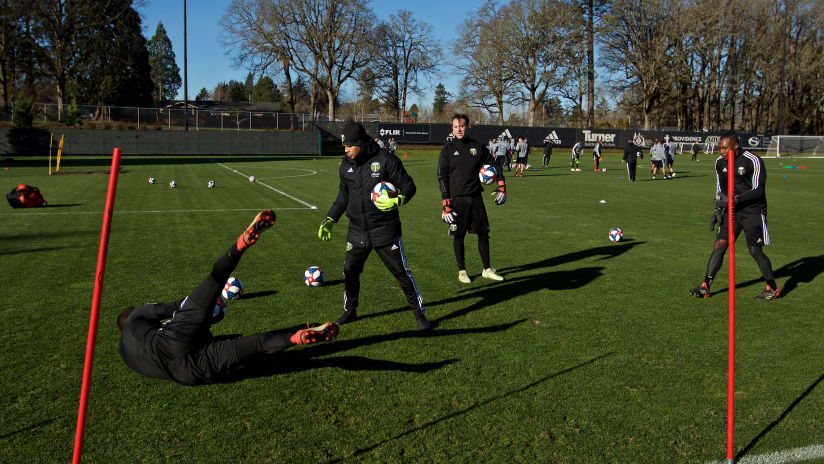This is the second installment of what, once it’s done, will be eight posts going through the depth charts of both the Portland Timbers and Thorns FC. As we did with the Thorns last week, we start on the Timbers side with an area of uncertainty: the team’s evolving options in goal:
Rostered goalkeepers (in alphabetical order): Jeff Attinella, Aljaz Ivacic. (Timbers also retain the MLS rights to Steve Clark)
On Thursday, the Portland Timbers went through Major League Soccer’s annual practice of verifying their roster, and as was the case for the league’s other 25 clubs, the practice also served as a reveal. For the time this offseason, fans were given a clear glimpse of the team’s current depth chart, with options that have been exercised (or declined) at each position also giving them a picture of their team’s needs. Though ongoing negotiations and the potential for extended loans lend some nuance to each level of that chart, we know where the foundations sit, now.
Consider the goalkeeper position, as our first example. Going into last offseason, the Timbers looked pretty: Jeff Attinella was returning as the team’s starter; Steve Clark was working on his return as the number two; Kendall McIntosh would provide depth and a Timbers 2 option; while Slovenian Aljaz Ivacic was in the process of coming over from Europe. Injury and opportunity saw those roles evolve throughout 2019, but for the most part, early in last season’s process, the actors were lined up.
Oh, how different this offseason feels. Clark asserted himself as the team’s starting goalkeeper but is also out of contract, at the moment. In the team’s postseason press conference, Portland’s president of soccer, Gavin Wilkinson, expressed a desire to bring last year’s number one back.
“We’re hopeful Steve Clark will be back,” Wilkinson said, last month. “We have his rights within MLS … it’s a player that I’m in constant contact with the agent, and we are hopeful that he is back next year.”
Thursday’s announcement provided some insight on the process. According to that release, the team has made Clark a bona fide offer. That’s very specific language, something that goes back to the league’s Collective Bargaining Agreement with its players. A player doesn’t have to accept a bona fide offer, but in order for a team to retain his rights, the club has to extend one. There are also rules about how much a team’s required to offer – an offer that’s based on the player’s previous salary. Between that value and what the player wants, the negotiations persist.
If the sides find a middle ground, Clark will be back and undoubtedly, just like last season, be given a crack at the Timbers’ starting job. But as two years under head coach Giovanni Savarese have shown, the player starts the first game shouldn’t necessarily be considered the Timbers’ clear starter. Early in the 2018 season, Attinella took over for Jake Gleeson, just as early in the 2019 campaign, Clark stepped in for Attinella.
This year, Attinella is coming off shoulder surgery. “We expect him to be at full participation mid-February,” Wilkinson said, and if he is, Portland will have a second goalkeeper capable of playing at a starter’s level. In addition, if Attinella’s recovery goes as planned, the Timbers have some insurance against the possible departure of Clark.
Whether that departure happens impacts how others should perceive the team’s depth. Last year, McIntosh’s presence gave the team a solid third option even before Ivacic’s arrival. McIntosh has had his contract option declined, though, and will be available in the coming Re-Entry Draft. The 25-year-old is thought of highly by his Timbers peers and was a constant standout with T2, but depending on how the Re-Entry process plays out, his time in Portland looks to be over.
That means Portland’s goalkeeping depth chart could, depending on how the Clark negotiations play out, be down to two – Attinella and Ivacic – meaning the Slovenian’s adaptation to to U.S. soccer will become more urgent. Requiring surgery to start the 2019 season, Ivacic got a late start on his first year in Portland, not appearing in a game until June 16. That match was with T2, just like the rest of his appearances in year one, when he eventually accumulated 12 starts and conceded 26 times over 1080 minutes.
It would be too strong to call 2019 a lost year for Ivacic, but the adaptation process wasn’t smooth. “[He] needs a full preseason,” Wilkinson explained, but he also needs prolonged time competing with Attinella and Clark, as well as learning from goalkeeping coach Guillermo Valencia. Regardless, 2020 will arrive with questions surrounding the 25-year-old’s potential. He’ll need a normal year in order to start answering them.
Thus, we have the quandary of the Timbers’ goalkeeper depth chart, something that stands in stark contrast to where the team was a year ago. If Clark comes back and last year’s internal excitement around Ivacic comes good, Portland will be relatively deep. “I don’t think there are many teams in MLS that have these type of goalkeepers competing in that position,” Savarese said, “and we feel pretty strong about it, if everything finishes the way we think [the offseason] is going to end up … We feel pretty confident in every goalkeeper that we have.”
If those things happen, the optimism Savarese expressed in last month’s season-ending press conference could prove justified. If, however, Clark’s negotiations break down, Attinella’s recovery doesn’t go as planned, and Ivacic’s struggles continue, goalkeeper could be a point of concern.












